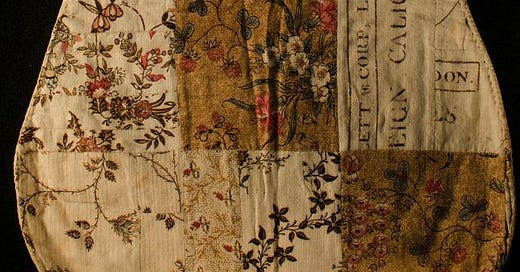Made of fabric, sometimes embroidered or monogrammed, and having long ribbon ties...
This is a pocket.
ACHC Collection #1933.027.1, 1800c.
As in the old nursery rhyme:
Lucy Locket lost her pocket,
Kitty Fisher found it;
Not a penny was there in it,
Only ribbon round it.
In 15th to 17th centuries, clothing didn’t have pockets. Food and necessities were carried by both men and women in rucksack kind of bags. These small bags were belted around the waist or slung from a rope.
It wasn’t until the 17th century that fashion turned to pockets of a sort. Men’s breeches and waistcoats began to have pockets sewn into the linings.
No sewn in pockets for women’s fashions though. Women still carried small bags tied around their waists under their outer garments. Keep in mind that the average 17th century woman wore a skirt, a petticoat and at least two other layers of undergarments. The pocket was usually hung between the petticoat and underpetticoat layers. Not exactly easily accessible.
However, women’s clothing did evolve to have slits in the dress and petticoat seams as well as the pockets, to make for easier access to a pockets' contents.
Diagram of a gown showing access to pockets, 1760s. Museum no. T.115-1953. Illustration from The Victoria and Albert Museum
And what would women carry in their pockets?
Theresa Tidy, in her 1819 book of Eighteen Maxims of Neatness and Order, lists the essentials for a pocket:
"It is also expedient to carry about you a purse, a thimble, a pincushion, a pencil, a knife and a pair of scissors, which will not only be an inexpressible source of comfort and independence, by removing the necessity of borrowing, but will secure the privilege of not lending these indispensable articles."
Additionally, one might carry keys, spectacles, a mirror, watch or a diary.
What do you keep in your pockets? Would Theresa Tidy approve?






